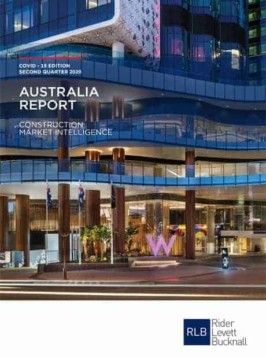According to the Rider Levett Bucknall (RLB) 2nd Quarter 2020 Australia Report, the impacts of COVID-19 being felt by Australian construction markets and associated tender costs differ around the country.
Peter Tulla, Oceania Chairman of RLB said, ‘Whilst tender prices were originally forecasted to be relatively stable across Australia in 2020 and 2021, this of course changed once we were hit with COVID-19.’
Opposing factors at play
He continued, ’RLB offices are seeing a relaxing of pressure on construction costs in Q2 2020 mainly due to the falling activity across Australia. The current consensus is that the general inputs into construction costs across Australia are generating many opposing factors. While there are some inputs that are increasing supply costs, the market dynamics of a reducing level of activity are seeing weaker tender prices.’
Peter noted that the markets are seeing conflicting impacts, such as the initial supply chain disruptions which occurred in Q1 2020, and then the government introduced construction measures to ensure levels of future work for the entire construction supply chain.
Planned projects put on hold or cancelled
According to a recent survey of RLB offices across Australia, 15% of projects that were in the final stages of pre-construction (design development, tender pricing etc.) are being put on hold or are progressing at a slower, more cautious pace.
Market indicators suggest a significant decline in commencement volumes over the next six to twelve months. As current projects finish and tower cranes are dismantled, there will be a considerable lag in project commencements until the market indicators return to ‘normal’.
In NSW, RLB estimates that approx. $300million worth of projects have been put on hold or cancelled.
Some shelved projects are now live due to COVID-19
Many other projects that were previously shelved are now live projects, and other ‘shovel-ready’ projects have probably had an easier path through planning and will go live earlier than they would have previously.
RLB in Victoria has circa $2-$2.5billion of projects to date that have either been deferred or put on hold as a direct result of COVID-19.
Gold Coast projects affected by border closures
In Queensland, RLB’s Brisbane projects are yet to see the effects of COVID-19 on their portfolio. RLB’s Gold Coast projects are very reliant on tourism and have been affected by border closures – the Gold Coast office has seen around $150million in deferred projects. In Townsville, RLB is experiencing around $80million of deferred projects.
Lack of pipeline projects a concern
These estimates exclude opportunities that were pulled before we had the opportunity to submit our fees, and the biggest fear is the potential lack of pipeline projects. RLB in South Australia has seen $1billion worth of projects deferred or put on hold due to the impact of COVID-19, however a number of clients are gaining confidence to either continue the design process or get ready to go to tender.
Conflicting economic forces to cause stress in market
In the coming months, as the construction industry contends with many conflicting economic forces, we expect to see elements of stress in the market. This will cause building cost fluctuations as the industry deals with:
- Supply chain disruptions
- Negotiation of new onsite EBAs
- Potential insolvencies within the sector as government incentives wind down
- Maintaining the recently introduced on site working procedures
- Drastically reduced demand for new housing from levels seen over the past few years
- Lack of investment in non-residential sector
- Changing contractual risk allocations between contractors and principals caused by the uncertainty in time and cost claims from the effects of COVID-19
- Volatility in foreign exchange movements
Period of uncertainty in contractor tender pricing
Peter added, ‘All of these impacts may cause downward shifts in tender costs as contractors and sub-contractors reduce margins and try to rebuild their pipelines of work, while increases may be seen in general labour rates (caused by EBA increases), material price increases and contractor risk acceptance.’
Whilst we have seen price increases across the country for structural steel, facades concrete, reinforcement and brick supply, actual tender prices have not yet reflected these material increases to their full extent.
Reducing construction volumes to increase competition but likely to increase costs
‘The reducing construction volumes are likely to increase competition and reduce margins. However volatile exchange rates, supply chain reliability and changing work practices resulting in lower productivity potentially increasing program durations, are all likely to increase costs,” he concluded.
RLB forecasted Tender Price Index annual movements have been downgraded since our last publication in Q4 2019. Current forecasts for 2020 and 2021 highlight the difference in annual rates due to the impact of COVID-19.
FURTHER INFORMATION:



